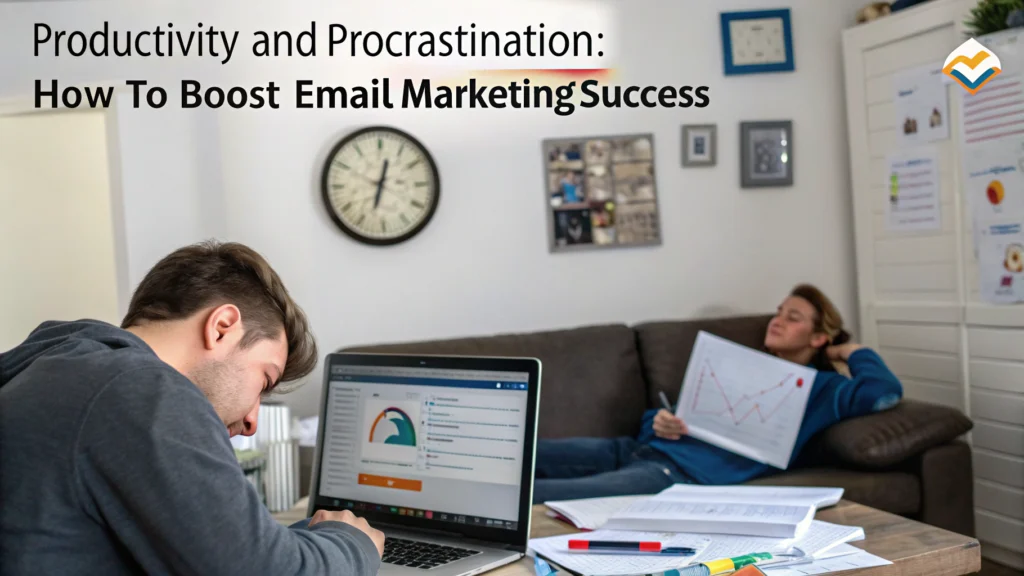Productivity and Procrastination: How to Boost Email Marketing Success
Are you tired of staring at your email marketing campaigns without making progress? Let's fix that today.
The battle between productivity and procrastination determines your email marketing success. I've been there – putting off campaign planning until deadlines loom, then rushing to send something mediocre.
The truth? Your ability to overcome procrastination directly impacts your bottom line.
Why We Procrastinate on Email Marketing Tasks
Procrastination isn't just laziness. It's often fear of disappointing results, perfectionism, or feeling overwhelmed by the technical aspects.
Common email marketing procrastination triggers:
- Uncertainty about what content will resonate
- Fear of making mistakes visible to your entire list
- Analysis paralysis when reviewing campaign metrics
- Overwhelm from constantly changing best practices
According to research, marketers waste up to 21% of their productive time procrastinating on high-impact tasks like email campaigns.
Ready to break this cycle? Let's dive into practical strategies to boost your email marketing productivity.
Productivity Tips to Transform Your Email Marketing
Implementing these
>productivity tips will dramatically improve your email marketing results:
1. Batch Similar Email Tasks Together
Context switching kills productivity. Instead of jumping between writing, design, and analytics, batch similar tasks:
- Monday: Plan email content for the week
- Tuesday: Write all email copy
- Wednesday: Design and format emails
- Thursday: Schedule and set up automation rules
- Friday: Review analytics and plan improvements
This approach can increase your efficiency by 30-40%, as your brain doesn't waste energy transitioning between different types of work.
2. Create Email Templates and Swipe Files
Stop reinventing the wheel for every campaign. Build a library of:
- High-converting subject line formulas
- Email body templates for different purposes (promotional, educational, etc.)
- Proven call-to-action phrases
- Responsive design templates that work across devices
This resource library becomes your secret weapon for
>overcoming procrastination – when you have proven frameworks ready to go, starting new campaigns becomes much easier.
3. Implement the Two-Minute Rule
If an email marketing task takes less than two minutes (like responding to a subscriber question or fixing a broken link), do it immediately.
This prevents small tasks from piling up and becoming overwhelming procrastination triggers later.
4. Use the Pomodoro Technique for Email Creation
The Pomodoro Technique works wonders for
>email marketing success:
- Set a timer for 25 minutes
- Work solely on one email marketing task
- Take a 5-minute break
- Repeat 4 times, then take a longer 15-30 minute break
This structured approach prevents burnout while maintaining focus on critical email tasks.

Overcoming Email Marketing Procrastination Triggers
Let's tackle the specific procrastination challenges that plague email marketers:
Analysis Paralysis: Making Data-Informed Decisions
Too much data can paralyze your decision-making. Combat this by:
- Identifying 3-5 key performance indicators (open rate, click rate, conversion rate)
- Setting specific thresholds for action (e.g., "If open rate drops below 18%, I'll test new subject lines")
- Creating a simple decision tree for common scenarios
Having clear guidelines eliminates the anxiety of interpreting endless metrics, boosting your
>boost email productivity.
Perfectionism: Embracing "Done" Over "Perfect"
Perfect is the enemy of done. Remember:
- An imperfect email sent is infinitely more effective than a "perfect" one never finished
- Most subscribers won't notice minor design flaws or typos
- You can always improve in the next campaign based on real performance data
Set a reasonable standard for "good enough" and commit to shipping when you reach that threshold.
Technical Overwhelm: Simplifying Your Email Stack
Modern email marketing platforms offer countless features, which can trigger procrastination through overwhelm. Combat this by:
- Mastering one feature at a time
- Creating step-by-step checklists for regular processes
- Focusing on the 20% of features that drive 80% of results
The
>AI for Productivity eBook + Checklist: Supercharge Your Efficiency in 2025 offers powerful frameworks to overcome technical challenges using AI tools.
Advanced Strategies for Email Marketing Productivity in 2025
Ready to level up? These advanced strategies will transform your email marketing workflow:
1. AI-Powered Content Creation
AI tools have revolutionized
>effective email campaigns. Use them to:
- Generate subject line variations for A/B testing
- Create personalized content based on subscriber segments
- Identify optimal send times for maximum engagement
This doesn't replace human creativity but accelerates the mundane parts of email creation.
2. Implement Progressive Analytics Reviews
Rather than falling down the analytics rabbit hole, schedule progressive reviews:
- Daily: Quick 5-minute check of critical metrics
- Weekly: 30-minute deep dive into campaign performance
- Monthly: 1-hour comprehensive analysis and strategy adjustment
This structured approach prevents analytics overload while ensuring data-driven decisions.
3. Templatize Decision-Making
Create decision matrices for common email marketing choices:
- When to resend to non-openers
- How to segment your list for specific campaigns
- When to retire underperforming automations
These frameworks eliminate decision fatigue and prevent procrastination on strategic choices.
The ADHD Productivity Connection
For marketers with attention challenges, email campaigns can be particularly challenging. The
>ADHD Productivity Power Pack: Ebooks, Guides, Checklists, Workbook & Tools to Master Focus, Time Management & Organization offers specialized techniques for:
- Maintaining focus during email creation
- Breaking down complex campaigns into manageable chunks
- Creating environment modifications that minimize distractions
Even if you don't have ADHD, these strategies work remarkably well for
>email marketing strategies 2025.
Creating Accountability Systems
Accountability dramatically reduces procrastination. Try:
- Setting public deadlines with your team
- Using project management tools with visible progress tracking
- Finding an "email buddy" to share goals and check in on progress
When others are aware of your commitments, you're significantly more likely to follow through.
Future-Proofing Your Email Productivity
As email marketing evolves, stay ahead by:
- Dedicating 2 hours weekly to learning emerging techniques
- Testing new tools in small-scale experiments before full adoption
- Building systems that scale with your list growth
This future-focused approach prevents technical debt that leads to productivity bottlenecks down the road.
Putting It All Together: Your 30-Day Productivity Plan
Ready to transform your email marketing productivity? Here's your 30-day roadmap:
Days 1-7: Foundation Building
- Audit current email workflow and identify procrastination triggers
- Create templates for common email types
- Set up your task batching schedule
Days 8-14: System Implementation
- Implement Pomodoro technique for email tasks
- Create decision matrices for common choices
- Set up progressive analytics review schedule
Days 15-30: Optimization and Mastery
- Test AI tools for content creation
- Refine your accountability system
- Measure productivity improvements and adjust
Following this plan will dramatically
>increase email engagement by eliminating the productivity barriers holding you back.
Conclusion
The battle between productivity and procrastination determines your email marketing outcomes. By implementing these strategies, you'll transform from an occasional email marketer to a consistent, high-performing email machine.
Remember: consistent imperfect action always beats perfect procrastination. Start with one technique today, and build your productivity muscle over time.
Ready to take your email productivity to the next level? Check out the
>AI for Productivity eBook + Checklist – it's packed with advanced strategies specifically designed for marketers ready to supercharge their results.
FAQ
How does procrastination specifically impact email marketing ROI?
Procrastination reduces email marketing ROI in several ways: it leads to rushed campaigns with suboptimal copy, missed timing opportunities, inconsistent sending schedules that reduce engagement, and insufficient testing. Studies show that marketers who implement structured anti-procrastination systems see up to 23% higher email conversion rates.
What's the optimal email creation workflow to avoid procrastination?
The most effective workflow follows four stages: (1) Planning (audience needs, objectives, key messages), (2) Creation (writing and design), (3) Review/Testing, and (4) Scheduling/Analysis. Using this structured approach prevents overwhelm and creates clear completion points for each stage.
How can I balance creativity with productivity in email marketing?
Schedule separate time blocks for creative ideation versus execution. Creative exploration needs unstructured time, while execution benefits from tight timeboxing. Many successful email marketers dedicate "creativity sessions" early in the week, then batch-produce content during focused execution phases later.
What tools help the most with email marketing productivity?
Beyond your email service provider, productivity leaders use: (1) Templates libraries, (2) AI writing assistants for first drafts, (3) Project management tools with email-specific workflows, (4) Analytics dashboards with decision thresholds, and (5) Calendar blocking apps to protect creation time.
How do I prevent email team burnout while maintaining productivity?
Sustainable email productivity requires: clear boundaries between work and rest, celebration of wins (not just more work), variety in campaign types to prevent creative fatigue, and regular skill development to maintain interest. Top teams also implement "no email Fridays" where they focus exclusively on analysis and strategy rather than creation.

